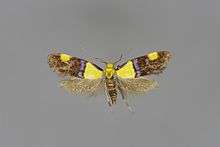Oecophora bractella
Oecophora bractella is a species of gelechioid moth. It belongs to the subfamily Oecophorinae of the concealer moth family (Oecophoridae). As the type species of its genus Oecophora, its affiliations and phylogeny (which are not completely known however) determine the delimitation of that family and subfamily.[1]
| Oecophora bractella | |
|---|---|
 | |
 | |
| Adult in Königsforst near Cologne (Germany) | |
| Scientific classification | |
| Kingdom: | |
| Phylum: | |
| Class: | |
| Order: | |
| Family: | |
| Genus: | |
| Species: | O. bractella |
| Binomial name | |
| Oecophora bractella | |
It is native to Europe[2], where it inhabits woodland. The species is not often found in the outlying regions; in the UK for example it has only been recorded from a few patches of old-growth forest in the English Midlands (e.g. Wyre Forest), southern England, and southern Wales (e.g. in the Wye valley).[3]
The adults' wingspan is 12–16 mm. Conspicuously bicolored black and yellow, they also have some iridescent blue markings on the forewings. The adult moths fly from May to July depending on the location; they are semi-diurnal and can be encountered during the day, but usually are active at dawn. The caterpillars feed on dead and decaying wood, and possibly also on fungi.[4]
Synonyms
This species has suffered from considerable confusion regarding its scientific name. It was first described by C. Linnaeus in 1758, who named it Tinea bractella. After the genus Oecophora had been established, its type species was set to be the Tinea sulphurella described by J.C. Fabricius in 1777. But that name was a junior homonym and thus invalid; Fabricius had actually described the "proper" T. sulphurella (nowadays known as Esperia sulphurella) himself, a mere two years earlier. Subsequent authors placed Linnaeus' species in the related genus Alabonia, while Fabricius' homonymy lingered on into the 20th century. Eventually this was all sorted out, when it was realized that the supposedly different species of Linnaeus and Fabricius were one and the same, and O. bractella has since been known under its current name.[5]
Invalid scientific names (junior synonyms and others) of Oecophora bractella are:
Footnotes
- Pitkin & Jenkins (2004), and see references in Savela (2001)
- Peterson, Merrill A. (2007). "First report of Oecophora bractella (L.) (Lepidoptera: Oecophoridae) in North America". Western Washington University.
- Kimber [2010]
- Grabe (1942), Kimber [2010]
- Grabe (1942), Pitkin & Jenkins (2004)
References
- Grabe, Albert (1942): Eigenartige Geschmacksrichtungen bei Kleinschmetterlingsraupen ["Strange tastes among micromoth caterpillars"]. Zeitschrift des Wiener Entomologen-Vereins 27: 105-109 [in German]. PDF fulltext
- Kimber, Ian [2010]: UKMoths – Oecophora bractella. Retrieved 2010-APR-27.
- Pitkin, Brian & Jenkins, Paul (2004): Butterflies and Moths of the World, Generic Names and their Type-species – Oecophora. Version of 2004-NOV-05. Retrieved 2010-APR-27.
- Savela, Markku (2001): Markku Savela's Lepidoptera and some other life forms – Oecophora. Version of 2001-NOV-07. Retrieved 2010-APR-27.
External links
| Wikimedia Commons has media related to Oecophora bractella. |